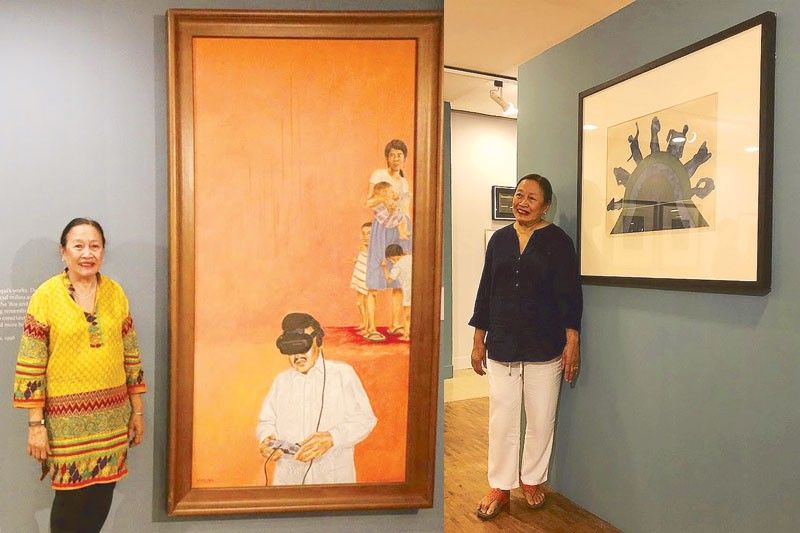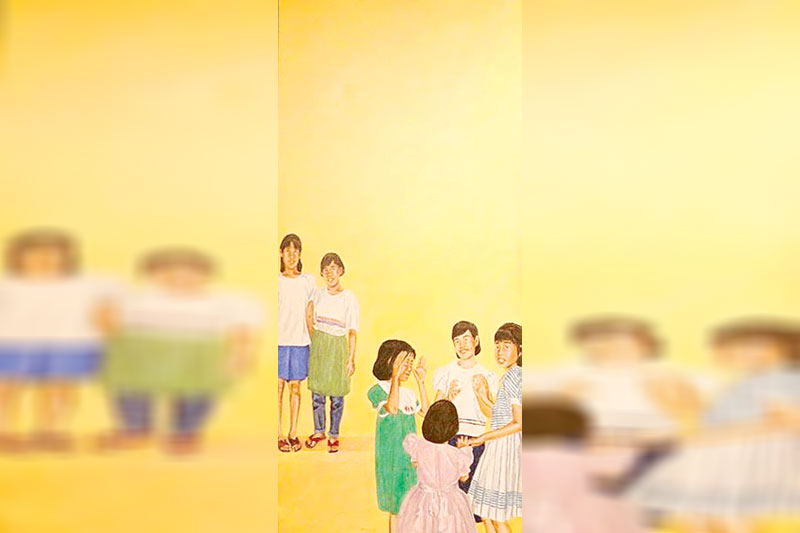Ofelia Gelvezon-Tequi: Home is where her Art is

Why Justice?
Gelvezon-Tequi explains: “Because I see the little ones don’t have a voice; they are easily thrown to the side. They do not get what is due to them. It’s justice that is due to the common man and for me that’s very important.”
One of the biggest names in contemporary Philippine Art, Gelvezon-Tequi is best known for her use of allegory in communicating her stand on socio-political realities. Hers is a voice that has been constant and true through the years.
“An artist has to show what he thinks and feels or his opinions through a language. In my case it’s colors and lines.You have to present it in such a way that, even if the message is universal, it’s personal also. I see something through my eyes, not somebody’s else’s eyes.” She adds that each artist uses his own artistic vocabulary.
One of the pioneers of printmaking in the Philippines, she is the first woman to be named a Thirteen Artist Awardee in 1972. In her day, she says, the Philippine art scene was dominated by men; one could count the number of women artists with one’s fingers.

About Gelvezon-Tequi, Reuben Ramas Cañete, in Pananaw 2, Philippine Journal of Visual Arts, 1998, wrote: “One characteristic has marked Ofelia Gelvezon-Tequi’s works: Despite their disparate inspirations, they all refer to the Filipino’s social milieu and history.From the clash of ideologies and cultures of the late ’60s to the ’80s and the departure to lands far away and ideas alien, to the yearning for long remembrances and a deep aspiration for return, Ofie has chronicled the Filipino consciousness in a way few artists have done, with lesser machismo and more bravura…”
Running until May 24, Gelvezon-Tequi’s works will be on display at the CCP Bulwagang Juan Luna or Main Gallery. A presentation of the CCP as part of its 50th anniversary program, the exhibit is entitled “Allegories & Realities Ofelia Gelvezon-Tequi: In Retrospect” and is curated by Ma. Victoria Herrera, former head of CCP Visual Arts and now director and chief curator of the Ateneo Arts Gallery.
Herrera reveals that Gelvezon-Tequi’s works have always been among her favorites in the CCP collection. Finding the right name for the retrospective took Herrera quite a while. She wanted a title that best described the works of Gelvezon-Tequi.
Many of the works in the show are allegorical statements, Herrera says, but she also realized how connected the artist was to Philippine realities despite the fact that she had been living away from the country for a long time, hence the title. Allegories & Realities is the first major art show of the CCP this year and it is also the largest that brings together the works of Gelvezon-Tequi, with 219 works on display.

A series of self-portraits is among the first of Gelvezon-Tequi’s works that viewers will see in the Main Gallery.
The print of Sta. Ofelia Virgin y Martir, whose face is Gelvezon-Tequi’s own, evolved from a series of stampitas. It shows the artist surrounded by the tools of her trade as a printmaker. There are prints that show her as a little girl in the homes she lived in – in Paco, Iloilo and Lucena. Her father, she reveals, was in the Philippine Army and was assigned to many places. She points to a picture, a kind of homage to him, of her father’s friends, seated in a row, at his wake.
As one rounds the corner to the main hall of the gallery, one finds the tryptiques on Bad Government and Good Government. This series was inspired by Ambrogio Lorenzetti’s frescoes in Siena’s Palazzo Pubblico. One depicts Bad Government and the other Good Government. “I transposed it in the Philippine setting,” Gelvezon-Tequi says.
“If you look at Bad Government, you’ll see it’s the tyrant that is surrounded not by virtues but by the vices vanity, pride and vainglory. He has his buwaya and tuta at his feet and advisers sneaking away. So what is the result of bad government in the city? You have riots and chaos.”
There is a family in the picture that Gelvezon-Tequi dressed in 19th century clothes to convey the idea that this situation has been a persistent one. “Nung araw pa! They have not been receiving justice.” She points to one of the figures in the picture, a politician holding a piece of paper. “Pumapapel,” she explains. “It’s a translation....these are Filipino words translated in images.”
The Good Government triptych depicts the artist’s vision of the ideal. “When there is justice, you can sleep soundly and even babes are not harmed by wild animals. The picture shows a kind ruler seated between Prudence and Magnanimity surrounded by the virtues faith, hope and charity.” The seal is that of the Philippine presidency. At the foot of the ruler lie sleeping babes and their mother. There is a group of people huddled below. Her husband Marc is among them, she says with a smile. Her sister is depicted as Liberty.
A brother, a sister, friends and household helpers considered as part of the family have figured in many of Gelvezon-Tequi’s works. Even the family dog Walter is memorialized in one of her stampitas in the Natividad series. Gelvezon-Tequi’s Joyful Mysteries are Filipino depictions of scenes of ordinary lives of ordinary people.

The Nativity, which is the third Joyful Mystery, shows a young couple (the woman is one of Gelvezon-Tequi’s household helpers) and their baby surrounded by a carabao, a cow and a yellow dog that have replaced the sheep and the ox.
The Visitation, the second Joyful Mystery, has two versions. One shows a woman, perhaps an OFW, arriving at a feast prepared by her family, and the other leaving them to return to work abroad. The woman, Gelvezon-Tequi says, is Pacing, another household helper of the family.
At the end of the Main Gallery are two huge paintings, visually arresting for their size and strong colors. They are not twin paintings, Gelvezon-Tequi says.
One has a former Philippine president standing in the foreground, wearing a Sony Playstation Virtual Reality headset and behind him, literally on the margins of the painting, a woman with two young children and an infant, forlorn and poor. The picture juxtaposes the disconnect between the most powerful man in the land and the marginalized in society. His reality is a different one from the mother and children, Gelvezon-Tequi says. He is blind to theirs.
To the left of this big painting is a variation of it – smaller and with Tibetan script in the background. Highlighted is the word for compassion at the center.
There is a little space, almost like a separate room, in the Main Gallery that is vastly different from the rest. On the walls are still lifes of the objects she found in the home she and her husband Marc bought in the 1990s in a little village called Limeuil, 560 kilometers from Paris, in southwest France.

Standing in this little room where her still lifes hang, she says: “Maybe, this is the peace I find in that village where we now live. My husband loves to say there are more animals than people in our village. It is very rural, we don’t have a grocery, we don’t have a post office, we have to hear mass in other villages.”
Her still lifes are of tables, decorative vegetables, an orchid, a bonsai tree, plates and jars – vessels that Gelvezon-Tequi says were used to contain walnut oil (walnuts grow aplenty in the region of France where she lives) among other things.
“I see they have lived before me...the fact that they have been used....it speaks of other lives and you imagine what those other lives were but they’re now part of your life...for me the bottom line is time.
“These are things that survived. If tables could speak they’d probably have their own memories. Now I take that table and put it in my world. I put my objects on it – the jars we found there, the Chinese pottery that we collected when we were living here in the Philippines. You take something and you use it.”
She points to the old table in one of the paintings. A label on the table reveals its provenance – Ivry and its destination, a village that is near Limeuil. The table’s journey fascinates her. “It has started to warp, the table. You see, it had a life before and that is what touches me.”
Gelvezon-Tequi loves to garden. She plants vegetables such as corn, tomatoes and green beans that her grandchildren like to pick and eat. She says it’s a good way of getting them to eat their veggies. A highland variety kangkong from the Philippines she is able to grow there as well. She plants flowers too and, recently, roses.
But the only flowers she paints are her orchids. “I don’t like cut flowers. Orchids are easy to move around.”
Gelvezon-Tequi and her husband Marc moved to Limeuil permanently in 2005. Married for more than 40 years, she met Marc in UP Diliman where he was teaching French. They have two sons and a daughter. There is a story that is often told of how she had spotted him at the UP Faculty Center and said, “Marc Tequi, may araw ka rin...at gabi.”
Their house in Limeuil is a 17th century structure but with a basement that is dated to the 13th century. “The house grew by accretion because we can tell from the different styles in the way the former owners had enlarged a space, or added another wing. You can see how the house evolved. There’s a door that’s very Romanesque and when you look at the basement we know that it was the main entrance before. Now, it is not.”
Through the years, Gelvezon-Tequi has lived in many places. In Hanoi, she says the light was different; the sky seemed low. In the Philippines, the light is strong and it was in Boracay where she says she witnessed the reddest sunset ever.
She loves the light of winter in France which she describes as “silvery.” But wherever she is, curator Herrera writes, Gelvezon-Tequi “maintains a consistent presence in the local art scene in spite of being a resident of France since 1973.”
Gelvezon-Tequi told Herrera: “I don’t address myself to the French, but to Filipinos.”
Allegories & Realities: Ofelia Gelvezon-Tequi, In Retrospect runs until May 24, 2020. For the first time, a set of nude drawings by the artist as a student at the Accademia di Belli Arti Di Roma will be seen publicly.
A corner in the CCP library will be devoted to the artist where visitors can read articles and books about her life and work. Exhibit viewing hours are 10 a.m. to 6 p.m. Tuesday to Sunday with extended hours until 10 p.m. on days with evening performances at the CCP Main Theater.
- Latest
- Trending

















